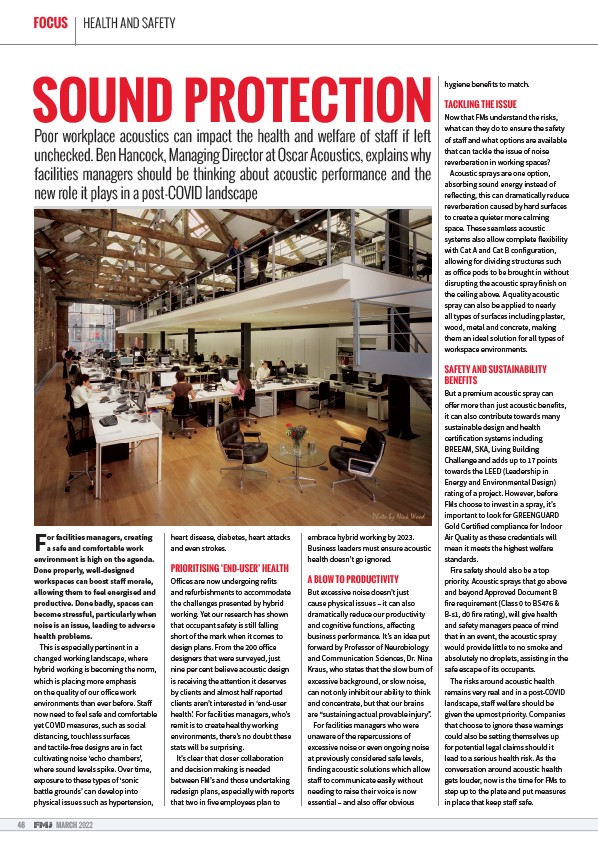
FOCUS HEALTH AND SAFETY
SOUND PROTECTION
For facilities managers, creating
a safe and comfortable work
environment is high on the agenda.
Done properly, well-designed
workspaces can boost sta morale,
allowing them to feel energised and
productive. Done badly, spaces can
become stressful, particularly when
noise is an issue, leading to adverse
health problems.
This is especially pertinent in a
changed working landscape, where
hybrid working is becoming the norm,
which is placing more emphasis
on the quality of our o ice work
environments than ever before. Sta
now need to feel safe and comfortable
yet COVID measures, such as social
distancing, touchless surfaces
and tactile-free designs are in fact
cultivating noise ‘echo chambers’,
where sound levels spike. Over time,
exposure to these types of ‘sonic
battle grounds’ can develop into
physical issues such as hypertension,
heart disease, diabetes, heart attacks
and even strokes.
PRIORITISING ‘END-USER’ HEALTH
O ices are now undergoing refits
and refurbishments to accommodate
the challenges presented by hybrid
working. Yet our research has shown
that occupant safety is still falling
short of the mark when it comes to
design plans. From the 200 o ice
designers that were surveyed, just
nine per cent believe acoustic design
is receiving the attention it deserves
by clients and almost half reported
clients aren’t interested in ‘end-user
health’. For facilities managers, who’s
remit is to create healthy working
environments, there’s no doubt these
stats will be surprising.
It’s clear that closer collaboration
and decision making is needed
between FM’s and those undertaking
redesign plans, especially with reports
that two in five employees plan to
embrace hybrid working by 2023.
Business leaders must ensure acoustic
health doesn’t go ignored.
A BLOW TO PRODUCTIVITY
But excessive noise doesn’t just
cause physical issues – it can also
dramatically reduce our productivity
and cognitive functions, a ecting
business performance. It’s an idea put
forward by Professor of Neurobiology
and Communication Sciences, Dr. Nina
Kraus, who states that the slow burn of
excessive background, or slow noise,
can not only inhibit our ability to think
and concentrate, but that our brains
are “sustaining actual provable injury”.
For facilities managers who were
unaware of the repercussions of
excessive noise or even ongoing noise
at previously considered safe levels,
finding acoustic solutions which allow
sta to communicate easily without
needing to raise their voice is now
essential – and also o er obvious
hygiene benefits to match.
TACKLING THE ISSUE
Now that FMs understand the risks,
what can they do to ensure the safety
of sta and what options are available
that can tackle the issue of noise
reverberation in working spaces?
Acoustic sprays are one option,
absorbing sound energy instead of
reflecting, this can dramatically reduce
reverberation caused by hard surfaces
to create a quieter more calming
space. These seamless acoustic
systems also allow complete flexibility
with Cat A and Cat B configuration,
allowing for dividing structures such
as o ice pods to be brought in without
disrupting the acoustic spray finish on
the ceiling above. A quality acoustic
spray can also be applied to nearly
all types of surfaces including plaster,
wood, metal and concrete, making
them an ideal solution for all types of
workspace environments.
SAFETY AND SUSTAINABILITY
BENEFITS
But a premium acoustic spray can
o er more than just acoustic benefits,
it can also contribute towards many
sustainable design and health
certification systems including
BREEAM, SKA, Living Building
Challenge and adds up to 17 points
towards the LEED (Leadership in
Energy and Environmental Design)
rating of a project. However, before
FMs choose to invest in a spray, it’s
important to look for GREENGUARD
Gold Certified compliance for Indoor
Air Quality as these credentials will
mean it meets the highest welfare
standards.
Fire safety should also be a top
priority. Acoustic sprays that go above
and beyond Approved Document B
fire requirement (Class 0 to BS476 &
B-s1, d0 fire rating), will give health
and safety managers peace of mind
that in an event, the acoustic spray
would provide little to no smoke and
absolutely no droplets, assisting in the
safe escape of its occupants.
The risks around acoustic health
remains very real and in a post-COVID
landscape, sta welfare should be
given the upmost priority. Companies
that choose to ignore these warnings
could also be setting themselves up
for potential legal claims should it
lead to a serious health risk. As the
conversation around acoustic health
gets louder, now is the time for FMs to
step up to the plate and put measures
in place that keep sta safe.
Poor workplace acoustics can impact the health and welfare of staff if left
unchecked. Ben Hancock, Managing Director at Oscar Acoustics, explains why
facilities managers should be thinking about acoustic performance and the
new role it plays in a post-COVID landscape
46 MARCH 2022